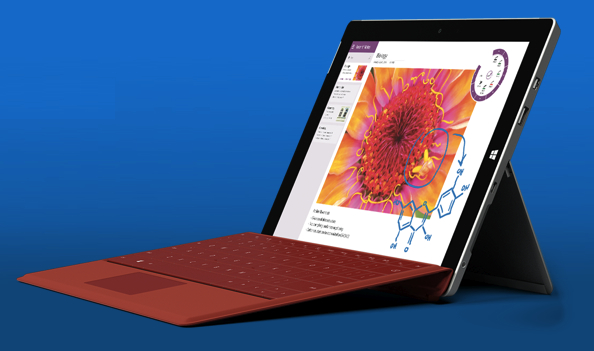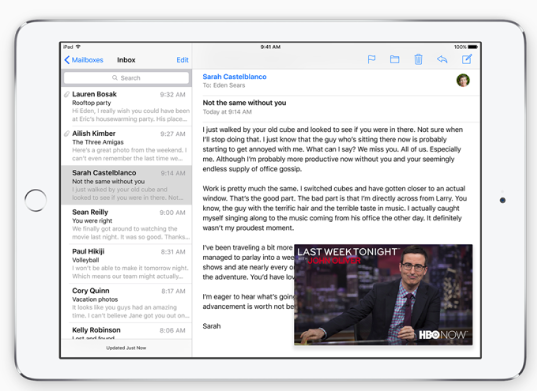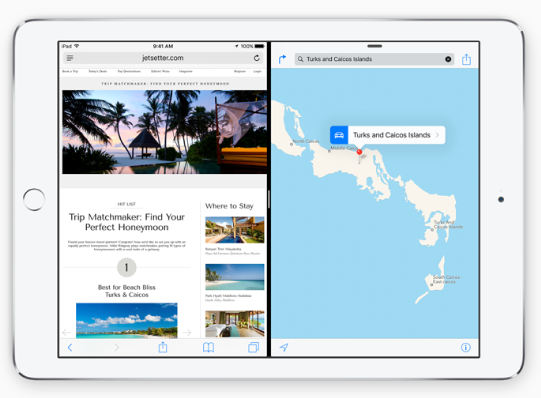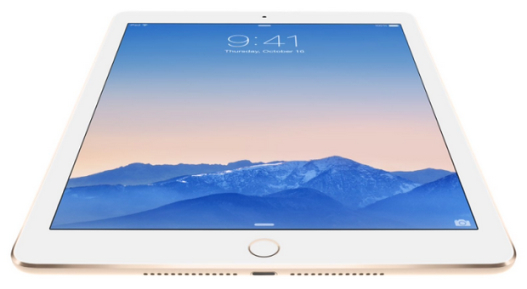Will Apple Make A 2-in-1 Laptop/Tablet Hybrid Device? – The ‘Book Mystique
Thus far, Apple has doggedly clung to the doctrine that laptops should be laptops and tablets should be tablets and never the twain shall meet. At least that’s their official line provisionally, but rumors are afoot that they have a 2-in-1 in the works.
It can’t have escaped Apple’s notice that Microsoft’s Surface 3 and Surface 3 Pro hybrids are enjoying relatively robust sales growth(especially since the affordably priced Surface 3 that supports desktop Windows software debuted a few months ago), while iPad sales growth has been stalled or eroding for more than a year, declining a whopping 15 percent in 2014 to 63.4 million units shipped from 74.3 million in 2013, sales in the most recent quarter down a whopping 23 percent year over year and the pace of decline accelerating. Apple is still selling much larger volumes of iPads than Microsoft is Surface devices, but the latter are acquiring rather than shedding market share. Microsoft doesn’t publicize product sales statistics, but it’s estimated that they shipped around 10.9 million Surface devices in 2014, which would account for a not-too-shabby roughly 4.6 percent of the total tablet and 2-in-1 market.
Cupertino will also certainly be aware of market analyst firm IDC’s projection that worldwide 2015 shipments of tablets and 2-in-1 devices will total some 221.8 million units overall, representing a 3.8 percent decline from 2014, but with some segments of the product category poised to experience strong growth this year and over the next few years.
Those would be cellular-capable tablets and 2-in-1 devices, with IDC Research Director, Tablets, Jean Philippe Bouchard, commenting: “Those cellular-connected devices fill multiple needs for vendors and carriers around the world; they offer a quick solution to price and margin erosion, and when compared to smartphones, they offer a less expensive way for carriers to increase their subscriber base.”
And while cellular-capable tablets and 2-in-1 devices still represent a small portion of the entire mobile computing device market,mother share is expected to grow in 2015 and beyond. IDC forecasts that this segment will enjoy a five-year compound annual growth rate (CAGR) of 5.6 percent compared to Wi-Fi-only devices, which will experience a negative five-year CAGR of -0.4 percent.
“A transition around size of the displays has also begun to take its course, with the share of small-screen tablets expected to drop from 64% of the market in 2014 to 58% in 2015, and declining to just under 50% by 2019,” says Ryan Reith, Program Director of IDC’s Worldwide Mobile Device Trackers. “This illustrates the direct impact phablets are having on the market, as users with larger screen smartphones have tended to have less need for a tablet with a screen size comparable to their smartphone. This also has some impact on overall average selling prices (ASPs) as larger screen devices tend to cost more.”
Computerworld’s Matt Hamblen recently polled several luminaries of the market analysis community, including IDC’s Bouchard and Reith, asking for direct comment on the likelihood of an Apple 2-in-1 device making it to market in the near-mid future. Mr. Bouchard was emphatically affirmative: “We’ll see it in 2015,” while Ryan Reith deduces that Apple will launch a larger-screen iPad in Q4 2015 with an optional Apple Keyboard, similar to the way Microsoft markets the Surface. Moor Insights & Strategy analyst Patrick Moorhead also thinks Apple will make some kind of 2-in-1 “eventually,” believing that a viable “product category exists between a MacBook and an iPad.”
Mr. Bouchard told Hamblen that in his estimation, 2-in-1s are the natural evolutionary path for tablets, including the iPad, to follow going forward, maintaining that there is plenty of potential for growth in tablets with keyboards, and that larger-screen tablets need hardware keyboards to truly become productivity tools. He also thinks Windows 10 will help accelerate the 2-in-1 trend with more touch optimization and precise stylus input, maintaining that “The tablet is not dying, but going into transition.”
Part of Apple’s iPad pain is self-inflicted. The iPhone 6 Plus has eaten into iPad sales — especially iPad mini volumes. IDC projects 8-inch and smaller panel tablets will representing less half of the overall tablet market by 2019 due to increasing popularity of phablets.
Personally, I’m of a mind that Apple’s refusal up to this week to equip the iPad/iOS with productivity features like real multi-window multitasking, file level directory access, the ability for the iOS version of Spotlight to universally search file contents, and mouse support has significantly hurt iPad sales growth.
Apple has now partly addressed iPad’s shortcomings as a work computer as of Monday’s World Wide Developers’ Conference keynote, in which it announced that a new feature called “SlideOver” is coming in iOS 9 that will allow you to designate an app that can always be summoned to the foreground with a simple swipe, although at the outset it only works with Apple’s own apps. Third parties will presumably step up with compatibility as well with Apple supplying APIs that make it easy for third-party developers to add SideOver support to their apps. SlideOver will work in concert with a revamped app switcher that will feature a CoverFlow-esque motif for selecting which of your currently running apps you want frontmost, and lets you take a quick look at another app without sending your primary app of the moment into the background.
Another new iOS 9 capability called Picture-in-Picture overlays a small video player window on your primary open app so you can disrupt your concentration on whatever you’re doing by keeping an eye on the PiP window’s content while working in another app. The iPad mini 2, iPad mini 3, and the original iPad Air will support Picture-in-Picture,
Finally, and most importantly for those of us who are production oriented, is Split View, which allows two open apps to occupy your display simultaneously, either in 50/50 or 70/30 allocations of screen real estate. However, only the iPad Air 2 will support the full “Split View” two-app multitasking capability, which will be criticized by some as a cynical ploy to goose iPad Air 2 sales by imposing a gratuitous hardware support cut-off. I expect it is deliberate, and that A7 powered iPads at least could probably handle Split View adequately enough, but I would say “desperate” rather than cynical (see sales growth/shrinkage metrics discussed above).
One of Apple’s major problems with the iPad, likely the main one, has been the upgrade cycle, with after five years no statistically dominant interval having been yet established yet. That’s partly because iPads are so solidly engineered and well-constructed that they last like anvils, but also because Apple has been relatively generous with software and OS backwards compatibility, so a 2011 iPad 2 for example still supports current iOS 8 and runs most apps well enough to satisfy non power users. Consequently, Apple needs a lever to prod users of older iPads to upgrade their hardware systems, and a marquee feature like Split View, for which there is much pent-up demand, should help address the sales slide. Complainers might ponder that if they like and value the iPad as a content consumption device and tool, its continued development will depend somewhat on Apple having a compelling business case for keeping is available.
And note well that Apple is being a good sport by making the core iOS 9 support all hardware that iOS 8 does (iPad 2/iPhone 4S and up), and with claimed improved performance.
The iOS 9 on-screen virtual keyboard will also get a makeover (again) with new support for task shortcuts, extra buttons for text formatting, and cut, copy, and paste or switching to the Camera app from the keyboard, and new Shortcut Bar displays actions tailored for the app you are in. A two-finger press in the keyboard area will summon a virtual trackpad.
This is all very welcome, and in the near term it should boost iPad Air 2 sales as some users of older model iPads upgrade to get the Split View feature. However, even with two window multitasking, the IOS still falls well short of laptop substitute capability on several of the above-noted capabilities.
This lamp blogger Rick Mansfield, who is Accordance Bible Software’s Technology Evangelist and an adjunct professor of Bible and philosophy at Indiana Wesleyan University, recently tried leaving his MacBook Pro home and just taking his iPad on a mini vacation of a few days duration. He reports “mixed results”, but ultimately, in more than one instance, he needed the MacBook Pro to complete a work task.
Likewise, Macworld’s Dan Moren left his 11-inch MacBook Air at home base and took only his iPad mini on a week-long European vacation, finding that while he was able to manage a rush freelance assignment that arrived while he was en route with just the iPad, he was reminded once again that the MacBook Air does the job much more efficiently — the same conclusion he arrived at with an experiment in 2012 when he tried working from an iPad exclusively for three days.
Of course likely millions of iPad users do use their tablets as production platforms, as I am right now drafting this article on mine, but those of us who do are abidingly frustrated by the fact that the addition of just a few enhancements would make the iPad a bona fide laptop surrogate. Apple has now made a good start on transforming the iPad into a truly useful work tool, but multiwindowing needs to be just a first step.




